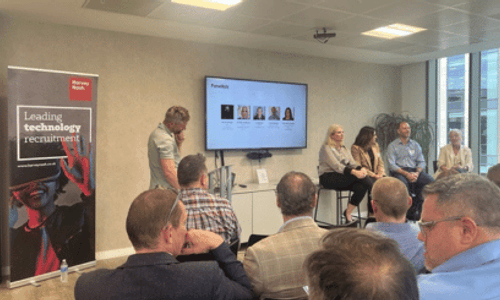
All News & Insights
Cybersecurity Trends 2025: A UK Hiring Outlook
Cybersecurity has taken centre stage in the UK this year. With threats growing more sophisticated and regulatory scrutiny tightening, businesses are investing heavily to protect their data, systems and people. As a result, demand for cyber professionals is climbing at pace, and the competition to secure top talent is intensifying.
At Harvey Nash, we’ve seen cybersecurity evolve from a back-office concern to a boardroom priority. Over the past year, the nature of hiring has shifted. Employers are looking for more than just technical firepower. They want strategic thinkers who can embed security into every part of the organisation.
2025 feels like a turning point. The risks are greater, the stakes are higher, and the need for experienced, capable cyber talent is now critical. As a recruitment partner, our role is to help organisations understand what’s happening in the market, and how to respond.
Why Cybersecurity Talent Is in High Demand
Across the UK, cyber threats are increasing in both frequency and severity. The Nash Squared/Harvey Nash Digital Leadership Report revealed 29% of digital leaders have experienced a major cyberattack in the past 2 years, ending a 5-year decline. The National Cyber Security Centre has also reported a significant rise in ransomware, phishing campaigns and attacks on critical infrastructure. For many businesses, the challenge is no longer just preventing breaches, but also being ready to respond, recover and learn.
At the same time, regulations are tightening. From data protection requirements to the Online Safety Act, organisations face growing pressure to demonstrate strong governance and accountability. For sectors like finance, healthcare, energy and the public sector, this is especially urgent.
Digital transformation is also playing a role. As cloud adoption accelerates and hybrid working becomes the norm, the attack surface expands. New technologies bring incredible opportunities, but also introduce new risks.
These combined forces are making cybersecurity talent one of the most sought-after resources in the UK job market today.
Key Cybersecurity Trends Shaping the UK in 2025
To understand the hiring landscape, it’s important to look at what’s actually happening on the ground. Here are the key trends shaping the cybersecurity conversation this year.
Ransomware remains a major threat
Attackers are becoming more targeted, more professional and more damaging, according to the Nash Squared/Harvey Nash Digital Leadership Report organised crime remains the biggest concern for digital leaders.
Public services, councils and healthcare providers continue to be high-profile victims. This is driving demand for security operations specialists, incident response teams and forensic analysts.
Supply chain risk is under the spotlight
Breaches linked to third-party providers have exposed vulnerabilities beyond company walls. In response, organisations are investing in governance, risk and compliance roles to help manage vendor relationships and strengthen oversight.
AI is creating both opportunities and risks
Artificial intelligence is helping defenders automate responses and improve detection. But it is also giving attackers new tools to generate phishing emails, create deepfakes or even write malicious code. Employers are starting to look for professionals who understand how to manage this emerging risk.
Data privacy is more important than ever
The UK Information Commissioner’s Office is taking a more assertive stance on enforcement, particularly around how customer data is stored and shared. This has led to growing interest in privacy-focused roles, especially in data-heavy sectors like retail and financial services.
Zero Trust architecture is gaining traction
Many organisations are moving towards a Zero Trust approach, where nobody inside or outside the network is trusted by default. This model requires specialists who understand identity management, access control and modern network design.
Cloud misconfigurations are still causing problems
Despite advances in tooling, simple mistakes in cloud setup continue to be a leading cause of breaches. This has made cloud security engineers essential, particularly those who can work closely with DevOps teams.
Human error remains a challenge
People are still at the heart of many breaches, whether through phishing, mis clicks or insider mistakes. Employers are increasingly focused on awareness, behaviour and building a culture of shared responsibility across their teams.
The Most In-Demand Cybersecurity Roles for 2025
The hiring market is being shaped by a push for resilience, agility and long-term thinking. Cybersecurity has emerged as the third most in-demand skill, with talent shortages up 6% on last year. These cyber focused roles are seeing consistent demand across the UK:
SOC Analyst – Specialists who monitor threats, investigate incidents and act as the first line of defence.
Typical salary: £40,000 to £60,000
Cloud Security Engineer – Experts in building and securing infrastructure in AWS, Azure or Google Cloud.
Typical salary: £70,000 to £100,000
GRC Specialist – Professionals who align security with risk, compliance and governance frameworks.
Typical salary: £60,000 to £90,000
IAM Lead – Focused on identity and access management, a vital area as companies adopt Zero Trust models.
Typical salary: £65,000 to £95,000
DevSecOps Engineer – Combining development, operations and embedded security across the software lifecycle.
Typical salary: £75,000 to £110,000
Threat Intelligence Analyst – Providing real-time insight into evolving threats and advising on proactive measures.
Typical salary: £50,000 to £85,000
Cybersecurity Analyst – A key all-rounder role, analysts monitor networks, investigate suspicious activity and support incident response efforts. They are often the first to identify and flag vulnerabilities.
Typical salary: £45,000 to £70,000
We’re also seeing new hybrid titles emerge, such as Cyber Risk Manager or AI Security Consultant, reflecting the broader integration of security across the business.
The Skills Employers Are Prioritising
Employers are looking for more than technical knowledge, they’re searching for people who can make a real impact.
Core technical skills include:
Cloud security
Incident response and threat hunting
Identity and access management
Zero Trust architecture
Familiarity with UK regulatory standards and NCSC guidance
Certifications often requested:
CISSP, CISM, CISA
CompTIA Security+
ISO 27001
Cloud security credentials (e.g. AWS or Azure certification)
Soft skills are playing a bigger role too:
Strong communication, especially with non-technical stakeholders
Problem-solving in fast-moving environments
Collaboration across departments
Adaptability and strategic thinking
Security is no longer confined to the IT team. Cyber professionals need to work closely with legal, operations, HR and even marketing , making soft skills essential.
Challenges in Hiring Cybersecurity Talent
There is no shortage of demand, but there are still real barriers when it comes to finding the right people.
There simply aren’t enough candidates, particularly in areas like cloud security, GRC and threat analysis.
Top talent is being snapped up quickly, often with multiple offers on the table.
Hiring processes can be too slow or not well aligned with the role, leading to missed opportunities.
Many employers struggle to assess technical capability, especially for niche roles.
Cybersecurity professionals often need to be approached directly. Many are not actively applying for jobs, but may be open to a change if the role and organisation feel right.
How Harvey Nash Supports Cybersecurity Recruitment
At Harvey Nash, we have been supporting UK organisations with technology recruitment for over 35 years. Cybersecurity is now a fast-growing part of that journey.
While this may be a newer specialism for us, we bring depth of experience, a broad talent network and a reputation for delivering results. We focus on understanding what makes each organisation unique, and tailoring our approach to find people who not only match the job description, but align with culture, values and long-term goals.
Our consultants are embedded in the UK technology ecosystem and speak to cyber professionals every day. We’re able to advise on salary expectations, skill trends, and how to position roles in a competitive market.
If you are building out your cyber team in 2025, and looking for a recruitment partner who understands both the urgency and complexity of the task, we’d love to talk. Please contact us here.
Find all our cybersecurity jobs here.
Conclusion
Cybersecurity is no longer just an IT issue, it’s a board-level priority and a key pillar of operational resilience. The landscape is changing fast, and the organisations that succeed will be those that invest early in the right people.
2025 is shaping up to be a defining year for cybersecurity hiring. Whether you’re scaling up your team, building capability from scratch, or rethinking your security strategy, the right talent can make all the difference.
At Harvey Nash, we’re here to help you navigate the market, connect with the right people and build a team fit for the future.
If you’d like to explore how we can support your cybersecurity hiring plans, get in touch with our team here.
Mo Gaibee – Cyber Security
Tech Talks: Emma Wright, Partner, Crowell & Moring
Cyber War Stories, Supply Chain Blind Spots & Why AI Is the New Risk Frontier
Cyberattacks are no longer an “if”—they’re a “when.”
Emma Wright, Partner at Crowell & Moring and a leading voice in privacy and cybersecurity law, joins Tech Talks to share what really happens when your systems go down, why supply chain vulnerabilities keep boards awake, and how ransomware gangs like Scattered Spider operate.
We explore the hidden weak spots, why basic attacks still succeed, and how boards can prepare for the chaos when—not if—a breach hits. Plus, Emma unpacks the legal and operational risks of rushing AI adoption without proper governance.
Tech Talks Podcast
Tech Talks is a podcast that probes the minds of tech leaders, hosted by Technology Evangelist David Savage. Each week, the show releases three episodes with new guests, covering the latest tech news, exploring new products and cultural transformations that drive the tech industry.
Founded in 2015 Tech Talks has published over 650 episodes and attracts over 18,500 streams a month from a global audience. The podcast offers insights and ideas from leading technologists on culture, innovation, finance, growth, sustainability, and more, providing a platform for the c-suite, founders, and senior figures to hear from others facing similar challenges and tap into a wider community.
Find out more about Tech Talks here.
How are employers rethinking talent to keep pace with AI innovation?
The demand for AI skills is outpacing supply at an extraordinary rate. According to the latest Nash Squared/Harvey Nash Digital Leadership Report, 51% of global tech leaders now say their organisation has an AI skills shortage, almost double the 28% reported just a year ago. AI has leapt from sixth to the number one most-scarce skill in just 18 months, marking the steepest rise seen in over 15 years of research.
Featured in a recent ZDNet article, Nash Squared CIO Ankur Anand , offers timely insight into why the gap has grown so significantly, and what organisations can do to address it. He points to the speed of innovation as a key factor:
“There’s an unprecedented pace of development in generative AI and the supporting large language models… Professionals must learn new skills quickly, and traditional learning methods can’t keep pace.”
The article explores how forward-thinking leaders are adapting, from rethinking recruitment to embedding continuous learning, and ensuring their organisations can attract and retain the right blend of AI expertise and ethical awareness.
You can read the full ZDNet article, including Ankur Anand’s insights and reflections on the fast-moving AI skills landscape, here.
Leeds Digital Leadership Report launch event highlights
On 16th July 2025, we gathered with some of Yorkshire’s most influential tech leaders to mark the Leeds launch of the Nash Squared / Harvey Nash Digital Leadership Report 2025. This wasn’t just a celebration of 26 years of industry-leading insight; it was a chance to reflect on how national and global trends are being shaped and challenged on a local level.
With data drawn from over 2,000 digital leaders across 62 countries, the DLR is a global barometer for tech strategy, transformation, and talent. But at our Leeds event, the spotlight was on the voices shaping that strategy here in the North.
What the data tells us
David Savage, Tech Evangelist at Nash Squared, opened the event by walking us through the key findings of this year’s report, highlighting rapid growth in AI investment, mounting cybersecurity concerns, the shifting shape of hybrid work, and how digital leaders are recalibrating priorities in an uncertain economic landscape.
But while the stats were compelling, it was the panel that brought the numbers to life.
Panel: Leadership in action
Our panel featured a diverse mix of digital leaders from across public services, healthcare, financial services and academia:
Jennifer Anderson, CIO, National Wealth Fund
Jo Graham, CDIO, Pharmacy2U
Ann-Marie Orange, CIO & Global Head of R&D, ArisGlobal
Tyrrell Basson, Director of Information Technology, University of York
Each panellist shared their lived experience of leadership, what’s shifting in their own teams, and how the report’s trends are unfolding in real-time.
Tech leadership is becoming more human
One of the strongest takeaways from the panel was how human the role of a digital leader has become. It’s no longer just about tools and transformation; it’s about trust, empathy, and bringing people with you.
The panel reflected on the challenge of modernising critical public infrastructure while maintaining public trust and securing stakeholder alignment. They also discussed the broader challenge of driving innovation in a way that builds confidence, ensures ethical implementation, and delivers meaningful outcomes, particularly when introducing technologies like AI that require cultural change as much as technical capability.
The panel highlighted the growing need for cross-functional leadership in increasingly tech-driven environments. Effective digital leaders, they noted, are those who blend technical expertise with emotional intelligence, and who understand that meaningful innovation is driven by people as much as by technology.
AI, skills and the new competitive edge
There was a clear consensus that AI is no longer a future trend; it’s today’s reality. But the panel pushed beyond the hype, focusing on how businesses can practically apply AI to drive outcomes, not just headlines.
The panel discussed the importance of investing in both infrastructure and people to support the growing role of AI across industries. They also touched on the widening digital skills gap, emphasising the shared responsibility organisations have, not just to adopt new technologies, but to help build and sustain the workforce needed to support them. A recurring theme was that while AI has the power to transform tasks, it’s human talent that will ultimately determine success.
Cyber resilience is a board-level conversation
With the report showing a rise in major cyber incidents, our panel didn’t shy away from tough conversations. There was agreement that cybersecurity can no longer be siloed within IT; leaders need to create cultures of cyber awareness and resilience across every level of the business. Importantly, this isn’t just a risk issue, but a leadership one.
Leeds: A digital hub with a human heart
The event highlighted what makes Leeds and the broader Yorkshire tech ecosystem so unique, with innovation grounded in purpose. Whether delivering public services, developing life-changing drugs, or rethinking education delivery, our panel showed that digital leadership here is values-led, community-focused, and deeply collaborative.
Thank you to our brilliant panel and all who attended for making the Leeds launch such a powerful conversation. We left with a deeper understanding of what it means to lead through change and how local leadership is helping to shape global impact.
Explore the full findings in the Nash Squared / Harvey Nash Digital Leadership Report 2025.
How are tech leaders securing the biggest pay rises?
Harvey Nash’s Helen Fleming, Executive Director, and Peter Birch, Director of Technology and Digital Executive Search recently featured in a Computing article exploring why some technology leaders are receiving inflation-busting salary increases, and what sets them apart.
Drawing on the latest insights from the 2025 Harvey Nash Digital Leadership Report, the article reveals that over half of technology leaders globally received a pay rise last year, with 11% securing an uplift of over 10%.
The data points to a clear pattern, the most rewarded leaders are working in businesses where technology is seen as a growth engine, not just a cost centre. These organisations are more likely to be investing in AI at scale, expanding their tech teams, and backed by leaders who view technology as a strategic enabler.
Helen and Peter share advice for tech leaders looking to improve their earning potential - from aligning with forward-thinking, tech-driven organisations to choosing sectors with stronger demand and budgets for senior digital talent, such as financial services, healthcare, and defense.
To find out how the most successful leaders are shaping their careers – and their compensation – read the full article in Computing.
Technology leaders embrace outsourcing as a solution to resourcing and skills gaps
Skills shortages continue to stalk the technology industry. Although not as acute as in the post-pandemic period, large proportions of technology leaders admit that skills shortages are holding them back. In this year’s Nash Squared/Harvey Nash Digital Leadership Report (DLR), AI tops the list with 51% of leaders reporting a skills shortage, but other areas rank highly too, notably big data/data engineering (36%), cyber security (33%), and cloud and platform engineers (26%).
It isn’t just that these skills are hard to find – some technology leaders may not have the headcount room to recruit additional staff. Although a healthy 41% of technology leaders expect to see headcount growth in their teams this year, this is down from 50% in 2023. Budgets follow a similar pattern – with a slight fall in leaders expecting a technology budget increase, from 45% in 2023 to 39% now. While many digital leaders are still anticipating headcount and budget growth, the numbers have subsided somewhat in a tighter economic environment.
The DLR shows us that for many technology leaders, at least part of the solution to this conundrum is outsourcing – using external solution providers for specific projects and activities. Over four in ten technology leaders expect their use of outsourcing to increase in the coming year, compared to 34% who say directly employed headcount will rise, and 29% who expect indirectly employed headcount (contractors, temporary staff) to increase. Only 15% of leaders expect outsourcing to decrease, a much lower proportion than those who say that of direct employment (25%) and indirect (20%). Tech leaders’ sentiment towards increasing outsourcing in the coming year has been backed up by Statista, that forecasts the IT outsourcing market will be worth £44bn in 2025, with a projected annual growth rate of over 9% from 2025-2029.
Outsourcing attractions
Given the cost of outsourcing as a solution, it may seem almost counter-intuitive that it tops the list at a time of economic caution. However, I believe there are a number of compelling factors that are putting it higher on tech leaders’ agendas.
Firstly, outsourcing is very flexible. In times of uncertainty, having a resourcing model that can quickly ramp up and down as needed is appealing.
Secondly, it’s easy. Most organisations, certainly large ones, will have agreements already in place with a number of consultancies and solutions providers that can be activated or extended when needed. It’s a quick and straightforward fix to a resourcing or workload issue. It’s a reflection too of how the barrier between what lies inside an organisation and what lies outside has lowered. Technology itself, like cloud and the productisation of software and business activities that previously were home-grown, has made it easier for some things, especially operational activities, to be done externally. The explosion in remote working has lowered the barrier even further.
It is also a route to quality. With the right provider, backed up by precise SLAs and rigorous performance metrics, a buyer should be assuring themselves of a good outcome that achieves the goals and objectives set. It’s rather like the old saying that “no one got fired for buying IBM”. If you’re using a leading consultancy/solutions provider, you should be on safe ground. With ever more solutions specialists and niche providers in the market, it’s also possible to find support for practically any need – whether that’s a managed service, application transformation, cyber, data and AI, or cloud. There are often a number of wider benefits too. Beyond the immediate work they’re doing, a good consultancy will offer wider guidance, best practice insights and thought leadership on emerging areas such as AI.
But perhaps equal to all of these factors in the current climate is that outsourcing doesn’t add to headcount – it’s just spend. As long as there is room in the existing budget, there is no need – or only a limited one – for difficult discussions with HR or other leadership. At a time when the cost of employment is rising through NI increases, and when IR35 changes are also making the use of contractors more complicated, contracting with an outsourced service provider becomes more attractive.
Balancing resourcing models
This is something we’re seeing ourselves at Harvey Nash, where increasingly more clients are asking us to put together a team of people under a services agreement, rather than to recruit individuals in different roles. It’s a variation on going to a services provider and is becoming a more common ask across the recruitment industry.
That’s not to say other models won’t continue to be key. Indirect employment of contractors and freelancers remains another flexible tool that always grows when market conditions are tight. Meanwhile, organisations continue to hunt for the right talent to bring in internally. Tech leaders still place primacy on their own teams. Candidates with the requisite skills and experience remain in demand.
More than anything, our findings underline that managing technology in a continually evolving environment is complex. That’s why technology leaders need to juggle multiple resourcing models and continually assess the balance as they strive to help their businesses modernise, transform and grow.
Tech Talks: Raphael Güller, Chief Product Officer, Sweep
Sustainability Is Good Business—But Show Me the Numbers
Regulation. Data overload. Greenwashing. Welcome to the frontline of corporate sustainability.
In this episode, David speaks with Raphael Güller, Chief Product Officer at Sweep—a company helping businesses manage their carbon footprint with the same precision they apply to finance.
Raphael shares why compliance isn’t enough, why Scope 3 emissions are often ignored, and how AI and automation are reshaping sustainability from a reporting headache into a real business advantage.
This conversation is a must-listen for anyone serious about ESG strategy, proving ROI to the board, or building a resilient organisation in a low-carbon economy.
Tech Talks Podcast
Tech Talks is a podcast that probes the minds of tech leaders, hosted by Technology Evangelist David Savage. Each week, the show releases three episodes with new guests, covering the latest tech news, exploring new products and cultural transformations that drive the tech industry.
Founded in 2015 Tech Talks has published over 650 episodes and attracts over 18,500 streams a month from a global audience. The podcast offers insights and ideas from leading technologists on culture, innovation, finance, growth, sustainability, and more, providing a platform for the c-suite, founders, and senior figures to hear from others facing similar challenges and tap into a wider community.
Find out more about Tech Talks here.
Birmingham Digital Leadership Report Launch Event Highlights
On 26th June 2025, we gathered with a brilliant group of digital and business leaders in Birmingham to mark the regional launch of the Harvey Nash Digital Leadership Report 2025. The event brought together voices from across the Midlands to explore what digital leadership looks like in a time of constraint, transformation, and opportunity.
Now in its 26th year, the Digital Leadership Report is the world’s largest and longest-running survey of senior technology decision-makers. It continues to offer a unique lens into the evolving priorities, technologies, and risks shaping the digital landscape — and the leaders navigating it.
This year’s report draws on insights from 2,015 digital leaders across 62 countries. It captures a global moment of recalibration, where AI is moving from experimentation to execution, cybersecurity threats are rising again, and hybrid work continues to evolve. But more than anything, it reflects a shift in mindset: from growth at all costs to clarity, focus, and resilience.
Voices from the frontline of public sector transformation
The evening was hosted by Nash Squared’s Tech Evangelist, David Savage, and featured two keynote speakers who brought the report’s themes to life through the lens of public sector leadership.
Kelly Goodwin MBA, CITP MBCS, CIO at the University of Wolverhampton, opened the evening with a keynote focused on navigating digital transformation in higher education. Her presentation, titled “Mission Impossible: Finding power in priorities when investment slows,” explored how institutions can move beyond reactive decision-making and instead focus on strategic clarity. She spoke about the importance of prioritising what truly matters, especially when resources are limited, a theme that echoed the report’s finding that while investment is slowing, priorities are sharpening
Her emphasis on resilience over speed aligned with the report’s broader narrative around leadership recalibration. As AI adoption accelerates, digital leaders are being called to lead with intention, not urgency. The report revealed that organisations furthest ahead with AI are 24% more likely to be increasing tech headcount, particularly in areas like AI and data.
Kelly reinforced this by highlighting the need to build empowered teams that can drive transformation, not just implement it.
Doing more with less
Martin Sadler, Director of Digital & Technology Services at Birmingham City Council, followed with a keynote that offered a candid look at digital leadership in the context of financial constraint. His talk focused on the challenge of delivering scalable digital services in a time of budget pressure , a reality faced by many public sector organisations.
The report’s findings on board-level priorities felt especially relevant to the discussion. Despite signs of slowing investment, over half of digital leaders (53%) say their number one priority is using technology to improve operational efficiency.
Martin explored how this shift applies in the public sector, where the goal is not profit but public value. His reflections on cross-sector collaboration and strategic reinvestment brought the report’s themes into sharp focus, showing how local authorities can remain agile and impactful even in difficult circumstances.
AI, cybersecurity and the skills challenge
Both speakers touched on the growing role of AI in shaping digital strategy. The report shows that nearly 1 in 5 organisations are now running large-scale AI projects, almost double last year’s figure
But the message from Birmingham was clear: AI must be purposeful. It’s not about chasing trends, but about solving real problems and unlocking capacity.
Cybersecurity also featured prominently in the discussion. With 29% of digital leaders reporting a major cyberattack in the past two years, the report highlights a renewed urgency around digital risk
Martin spoke about embedding resilience into every layer of the organisation, not just in systems, but in culture and leadership.
The skills gap was another shared concern. The report revealed an 82% increase in organisations citing AI as their top skills challenge
Kelly addressed this directly, emphasising the need to invest in people, not just platforms. Her call to “build the A-Team” reflected a broader shift in leadership thinking, one that values capability, adaptability, and collaboration.
Beyond the numbers
The Birmingham launch wasn’t just a presentation of findings; it was a conversation. A moment to reflect on the data, but also to hear how it’s being lived, challenged, and reimagined by leaders on the ground. From universities to city councils, the evening showcased the courage, creativity, and clarity that define today’s digital leadership.
Thank you to our keynote speakers, Kelly Goodwin and Martin Sadler, and to all our guests for making the Birmingham launch such a thoughtful and noteworthy event.
Tech Talks: Simon Collins, Deputy Head, Bedlington Academy
Lessons in Leadership: What schools can teach the tech industry
David returns to his old school, Bedlington Academy, for a powerful conversation with Deputy Head Simon Collins. On the surface, it’s a story about education. But listen closely and it’s a story every business leader needs to hear. Simon reveals how modern schools are navigating AI, digital literacy, and real-world career paths—while building resilience, independence, and ambition in communities too often overlooked.
From AI in the classroom to unlocking aspiration in post-industrial towns, this isn’t just a lesson in pedagogy—it’s a call to industry to meet education halfway.
Education and tech have more in common than you’d think—fast-moving environments, shifting expectations, and a duty to prepare people for the future. In this episode, Simon Collins unpacks how schools like Bedlington Academy are embracing AI, personal development, and creativity to prepare students for careers that didn’t exist a decade ago. He’s clear: the tech world needs to show up, not just with advice—but with collaboration, empathy, and opportunity.
Tech Talks Podcast
Tech Talks is a podcast that probes the minds of tech leaders, hosted by Technology Evangelist David Savage. Each week, the show releases three episodes with new guests, covering the latest tech news, exploring new products and cultural transformations that drive the tech industry.
Founded in 2015 Tech Talks has published over 650 episodes and attracts over 18,500 streams a month from a global audience. The podcast offers insights and ideas from leading technologists on culture, innovation, finance, growth, sustainability, and more, providing a platform for the c-suite, founders, and senior figures to hear from others facing similar challenges and tap into a wider community.
Find out more about Tech Talks here.
Get in touch
If you're looking to secure your next role or make your next best hire, we'd love to help. Get in touch to speak with one of our consultants today.









